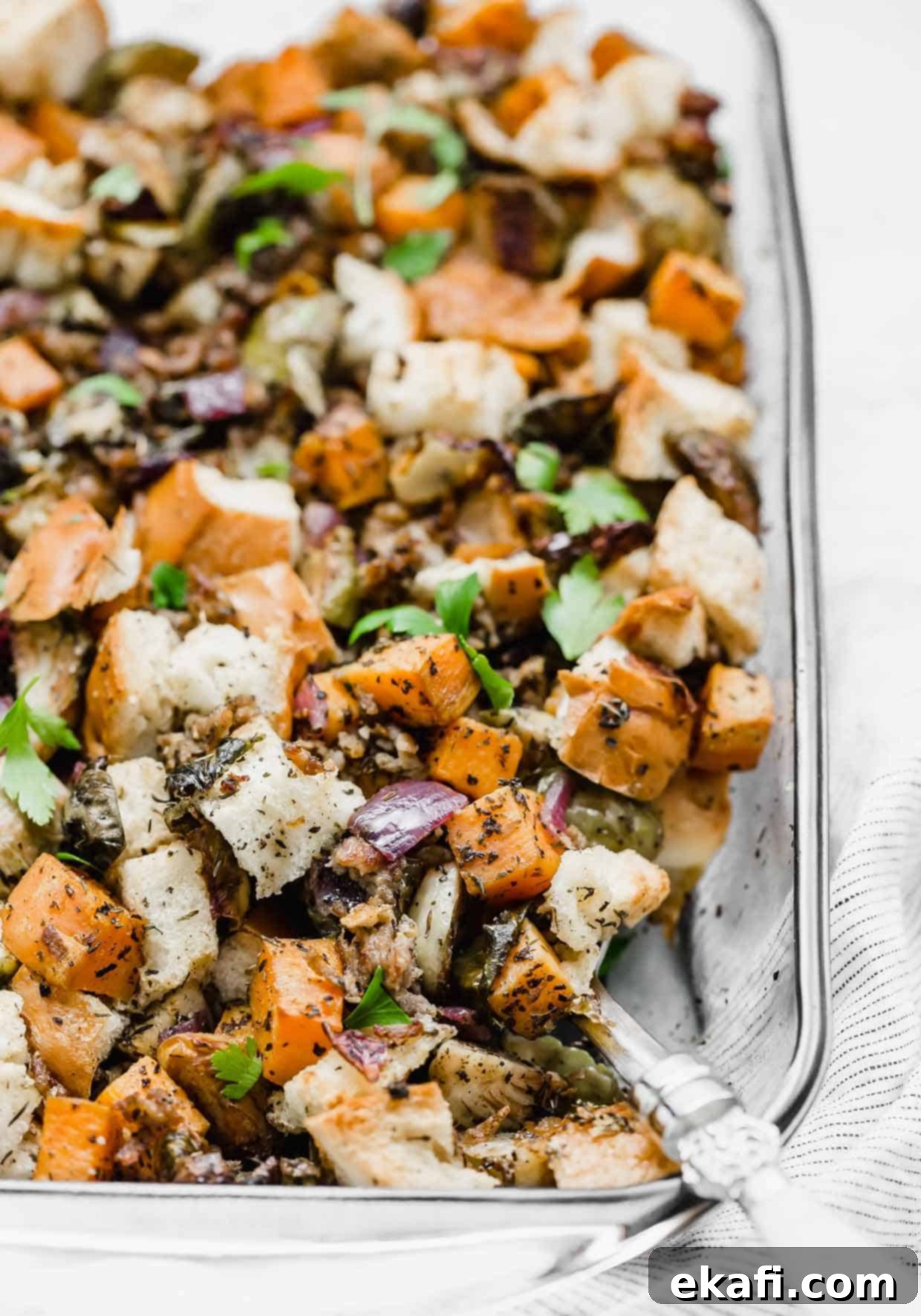Savory Italian Sausage Stuffing: A French Bread Recipe with Sweet Potato & Brussels Sprouts
Elevate your holiday table or any autumn meal with this incredible **Italian Sausage Stuffing** recipe. Far from your average side dish, this savory French bread stuffing features a delightful combination of sweet Italian sausage, tender sweet potatoes, perfectly roasted Brussels sprouts, and aromatic onions, all brought together with a blend of delicious herbs and spices. It’s a truly unique and flavorful twist on traditional Thanksgiving Stuffing, guaranteed to become a new family favorite.
While often reserved for the Thanksgiving feast, this versatile and hearty stuffing is ideal for any fall gathering or even a cozy weeknight dinner. Its robust flavors and comforting textures make it a standout side dish throughout the cooler months. If you’re looking to complete your holiday menu, consider pairing it with other beloved autumn sides like Candied Apple Yams, Easy Sweet Potato Casserole, or Cinnamon Roasted Butternut Squash. This homemade Italian sausage stuffing adds a sophisticated yet rustic touch to any meal, proving that stuffing isn’t just for turkeys!
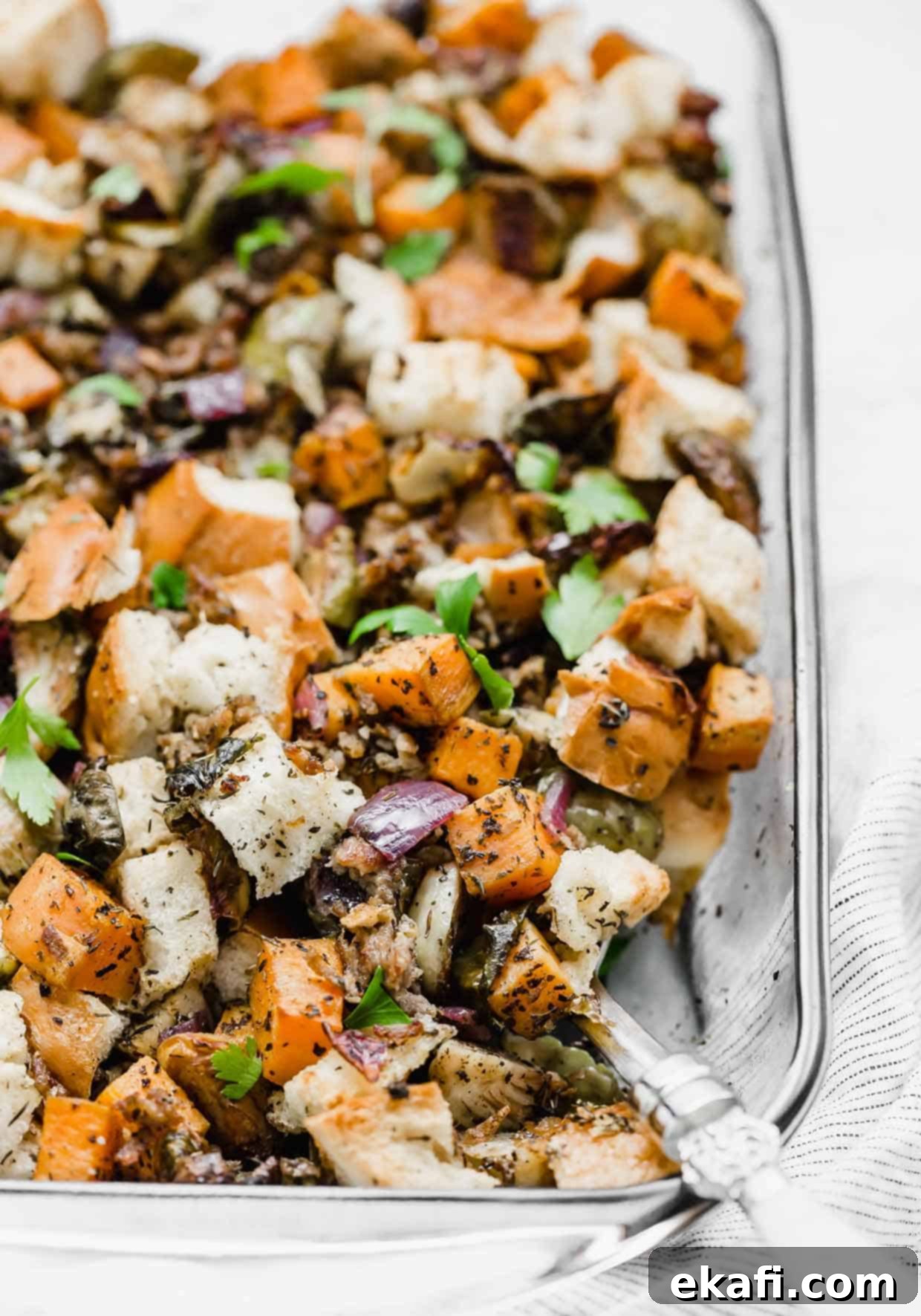
Why This Italian Sausage Stuffing Recipe Is a Must-Try
- Unforgettable Flavor and Texture: This isn’t just *any* Italian sausage stuffing; it’s arguably the best you’ll ever make! The harmonious blend of savory Italian sausage, naturally sweet potatoes, and slightly crisp Brussels sprouts creates an explosion of flavors and textures in every bite. It’s incredibly easy to put together, making it perfect for both seasoned cooks and those new to stuffing. The combination of ingredients ensures a deeply satisfying and comforting side dish.
- Remarkably Versatile and Customizable: One of the greatest advantages of this recipe is its adaptability. Not a fan of Brussels sprouts? No problem! Easily swap them for other root vegetables like parsnips, carrots, or even cubed butternut squash. This autumn vegetable stuffing welcomes your personal touch, allowing you to tailor it perfectly to your family’s preferences. Feel free to experiment with different herb combinations, add a touch of apple for a sweet-savory note, or include dried cranberries for a festive touch.
- Deep, Rich Flavor Profile: Unlike traditional stuffings that often rely solely on bread, onion, and celery, this recipe introduces sweet Italian sausage as a star ingredient. The sausage not only adds a delightful meaty element but also infuses the entire dish with incredible depth and umami flavor, transforming a classic side into an extraordinary culinary experience. The interplay of sweet, savory, and herbaceous notes is simply divine, making this sausage and herb stuffing truly standout.
Key Ingredients for Our Savory Sausage Stuffing
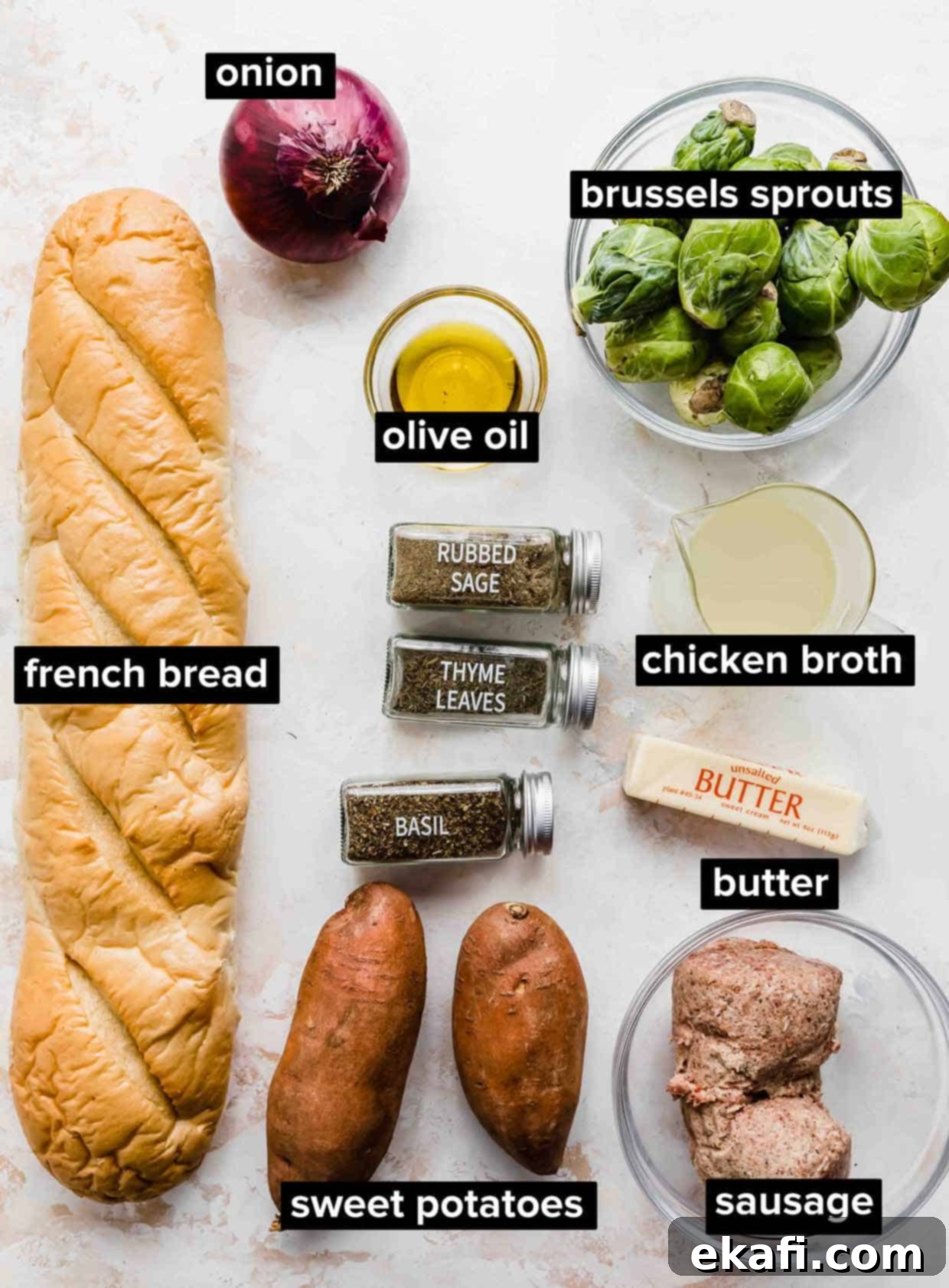
- French Bread: You’ll need approximately 10 cups of cubed bread. For this recipe, we recommend cutting a fresh loaf of French bread into 1-inch cubes. There’s no need for pre-stale or hard bread, as we will lightly toast it in the oven to achieve the perfect texture. Using French bread for stuffing is fantastic because its chewy crust adds a wonderful depth of character to the final dish, preventing it from becoming uniformly mushy.
- Sweet Italian Sausage: This is the star of our savory stuffing! While sweet Italian sausage offers a perfectly balanced flavor that most families adore, you can absolutely opt for hot Italian sausage if you prefer a spicier kick. We typically use Italian pork sausage, but feel free to substitute with turkey sausage for a leaner option without compromising on flavor. Make sure to crumble it well for even distribution.
- Sweet Potato: Adds a natural sweetness and creamy texture that beautifully complements the savory sausage. Don’t hesitate to use more sweet potato if you love its flavor! For even more variety and nutritional boost, consider incorporating other root vegetables like parsnips and carrots alongside the sweet potato.
- Red Onion: Provides a distinct pungent and slightly sweet flavor that mellows beautifully when roasted. While red onion offers a lovely color and taste, a sweet onion or yellow onion will work just as well if that’s what you have on hand. Ensure it’s finely diced to blend seamlessly into the stuffing mixture.
- Herbs: Our blend includes dried basil, rubbed sage, and thyme, with fresh parsley (or basil, thyme) for garnishing. While dried herbs are convenient and potent, elevating your stuffing with fresh herbs (using about three times the amount of dried) will impart an even brighter, more aromatic profile. Sage is particularly crucial for that classic, comforting stuffing flavor.
- Butter: Generous cubes of butter are essential for creating those irresistible pockets of rich, buttery deliciousness throughout the stuffing. As the butter melts during baking, it bastes the bread and vegetables, ensuring every bite of this sage sausage stuffing is incredibly moist, tender, and flavorful.
- Chicken Broth: The key to achieving the perfect stuffing consistency. You might not need to use all of the chicken broth listed; the amount required can vary based on the dryness of your bread and the moisture content of your vegetables. The goal is to moisten the bread sufficiently to create that classic stuffing texture, allowing it to absorb flavors without becoming soggy. Add it gradually, stirring well after each addition, until the mixture is just right.
Step-by-Step Instructions for Perfect Italian Sausage Stuffing
- Oven Toast the Bread to Perfection: Begin by preheating your oven to 400°F (200°C). Spread the 1-inch cubed French bread pieces evenly across a large baking sheet. Bake for 10-14 minutes, or until the bread cubes are lightly golden brown and slightly crisp. This crucial step prevents the stuffing from becoming overly mushy and provides a desirable texture. Once toasted, remove the bread from the oven and transfer it to a large mixing bowl to cool slightly while you prepare the other ingredients.
- Cook the Savory Sausage: Place the mild Italian sausage in a large skillet over medium heat. Using a spatula or spoon, actively break the sausage into small, uniform crumbly pieces as it cooks. Continue cooking for 8-10 minutes, or until the sausage is thoroughly browned and cooked through, with no pink remaining. It’s important to drain any excess grease from the skillet before transferring the cooked sausage to the bowl with the toasted bread cubes. This ensures your stuffing isn’t greasy and maintains a balanced flavor.
- Roast the Vibrant Veggies: In a medium-sized bowl, combine the quartered Brussels sprouts, peeled and cubed sweet potato, and cubed red onion. Drizzle with 2 tablespoons of olive oil, then season with 1 teaspoon of dried basil, 1 teaspoon of rubbed sage, and 1 teaspoon of thyme. Toss everything gently to ensure the vegetables are evenly coated with oil and spices. Spread the seasoned vegetables in a single layer on a large baking sheet and roast in the preheated 400°F (200°C) oven for 18-20 minutes. The vegetables should be slightly fork-tender but retain a bit of firmness – avoid over-softening them as they will continue to cook in the stuffing.
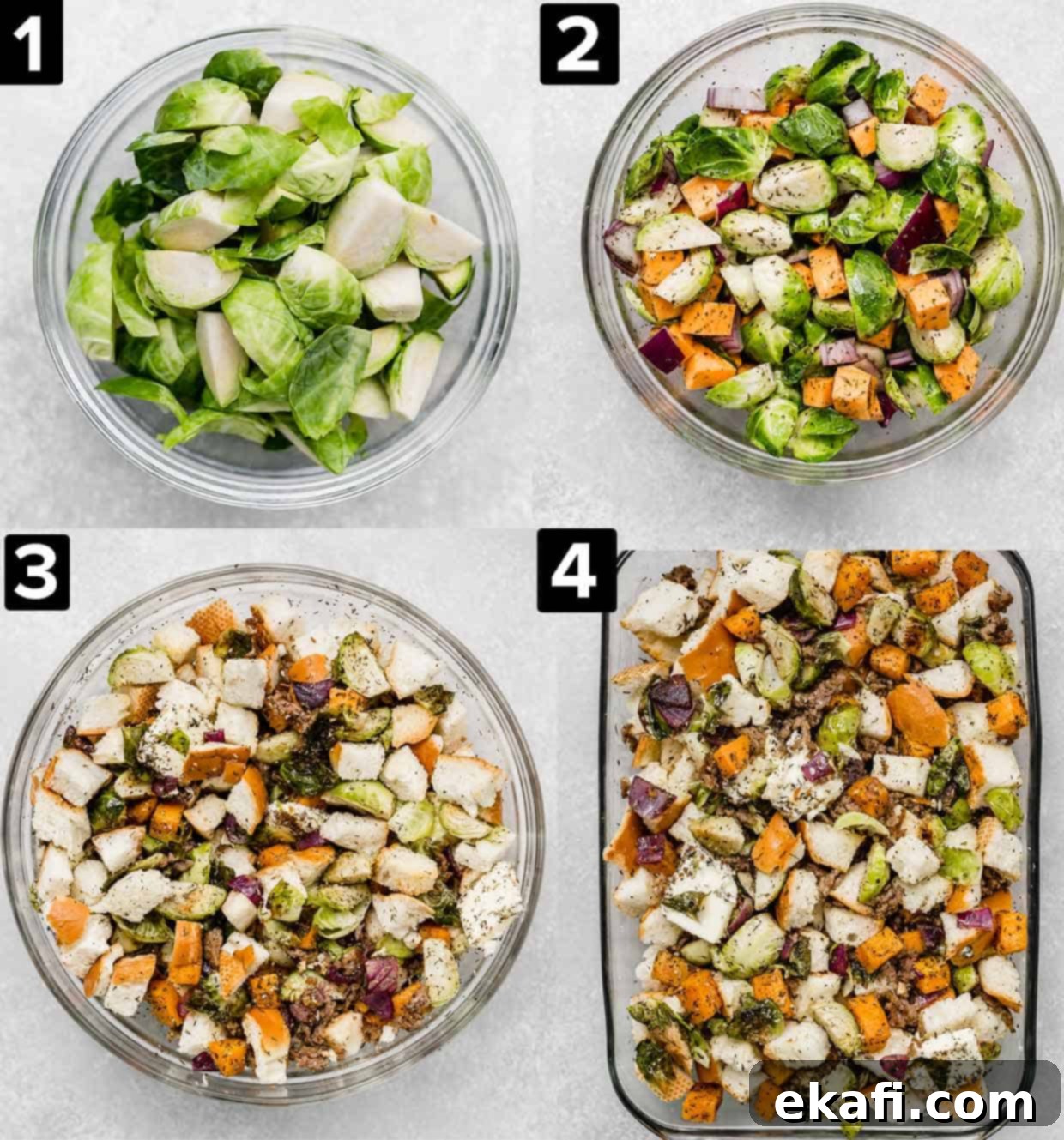
- Combine All the Delicious Elements: Add the roasted vegetables to the large bowl containing the toasted French bread and cooked sausage. Sprinkle in the remaining dried herbs (2 tsp basil, 2 tsp sage, 2 tsp thyme) and dot the mixture with the 6 tablespoons of cubed butter. Gently toss all the ingredients together until well combined. Now, slowly pour the chicken broth over the mixture while stirring continuously. Be mindful not to add too much broth at once; you want the bread to be moist and flavorful, absorbing the broth, but not waterlogged or soggy. The amount of broth can vary, so add just enough until the stuffing reaches your desired consistency.
- Bake to Golden Perfection: Transfer the combined vegetable and sausage stuffing mixture into a butter-greased 9×13-inch casserole dish, spreading it out evenly. Cover the dish tightly with aluminum foil and bake in a 375°F (190°C) oven for 25 minutes. After this initial baking period, remove the foil and continue to bake for an additional 20-25 minutes, or until all liquid has been absorbed, the top is beautifully golden brown, and the stuffing is heated through and slightly crispy on top. Remove from the oven, and if desired, garnish with fresh parsley or other fresh herbs before serving warm. This stuffing is best enjoyed straight from the oven!
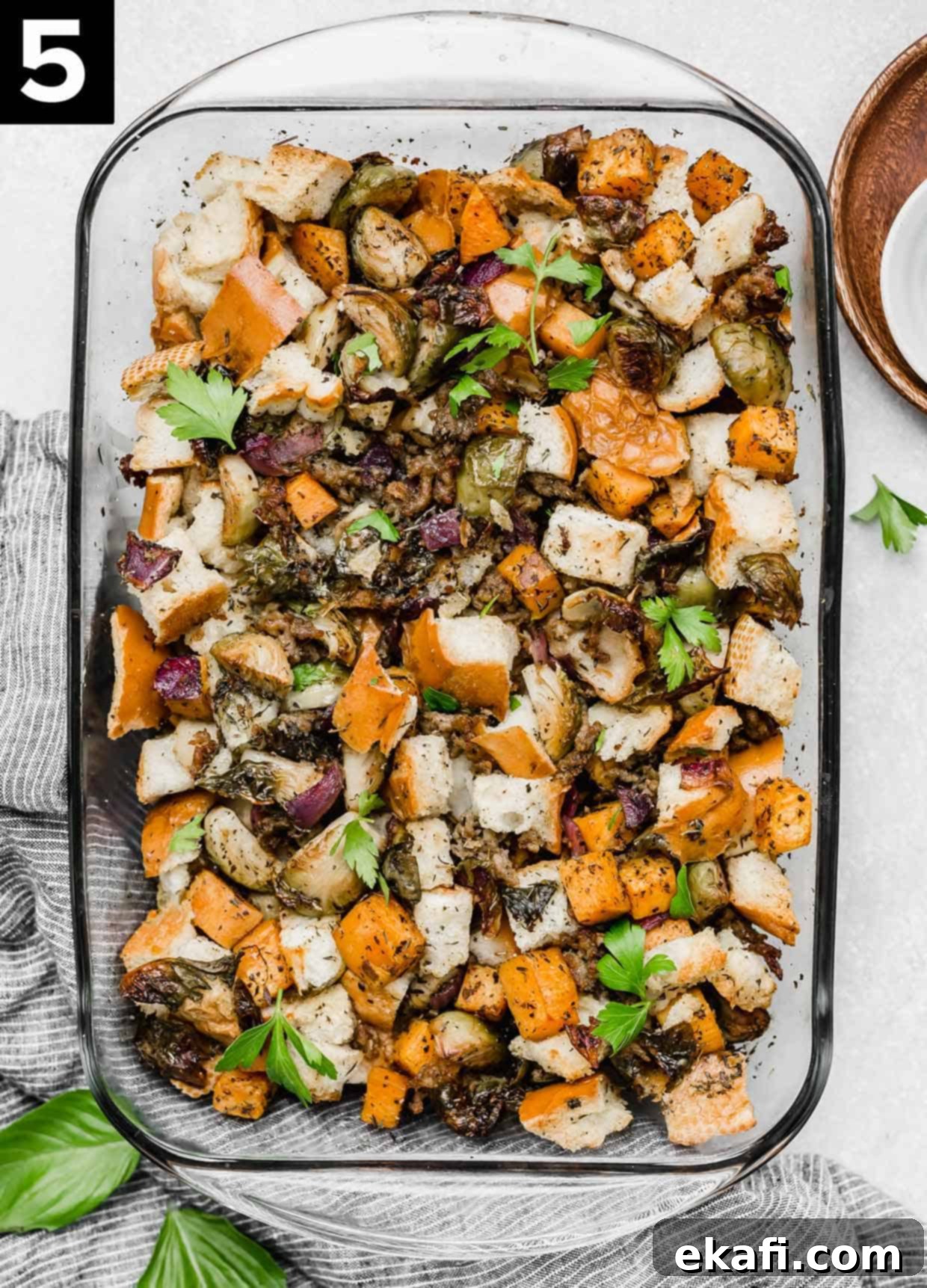
Expert Tips for the Best Italian Sausage Stuffing
For a lighter yet equally delicious option, consider using a multi-grain French bread instead of white French bread. This can add a nuttier flavor and additional fiber. Additionally, substituting the pork Italian sausage with turkey sausage can significantly reduce the fat content while maintaining a wonderful savory flavor. These small adjustments make for a healthier stuffing without sacrificing taste.
When toasting your French bread cubes in the oven, pay close attention to the color and texture. The goal is a lightly golden brown exterior, just enough to dry out the bread and give it structure, but not so much that it becomes dark, hard, or overly crunchy. Over-toasted bread can lead to a dry stuffing that doesn’t absorb the broth properly, resulting in a crumbly rather than cohesive texture.
If you’re using Italian sausage links instead of bulk sausage, remember to carefully remove the casings before cooking. This ensures the sausage crumbles nicely and blends seamlessly into the stuffing mixture. Many home cooks prefer using bulk sausage simply to bypass this extra step, saving valuable time and effort in the kitchen.
This French bread stuffing is incredibly adaptable! Feel free to customize the vegetable blend to your liking. Beyond sweet potatoes and Brussels sprouts, excellent additions include parsnips, carrots, finely diced celery, butternut squash, or even red potatoes. If Brussels sprouts aren’t a favorite at your table, simply omit them or swap them for another preferred vegetable like chopped bell peppers. This is *your* sausage vegetable stuffing – make it exactly how you and your family love it!
For convenience, you can certainly use store-bought stuffing cubes instead of fresh French bread. If opting for pre-made cubes, you can skip the initial bread toasting step entirely, as they are typically already dried and ready to absorb moisture. Just make sure to adjust the chicken broth amount as needed, as pre-packaged cubes might absorb liquid differently than freshly toasted bread.
Make Ahead, Storing, and Freezing Your Italian Sausage Stuffing
Preparing this delicious Italian sausage stuffing ahead of time can significantly ease your workload, especially during busy holidays. You can cook the sausage, roast the vegetables, and toast the bread components separately. The key is to keep the toasted bread uncovered at room temperature, rather than storing it in an airtight ziplock bag or container, which would cause it to soften prematurely and lose its desirable crispness.
If you wish to assemble the stuffing components the day before, you can combine the cooked sausage, roasted vegetables, and toasted bread in your casserole dish. Store this mixture covered loosely in the fridge overnight. However, it’s crucial **not to add the chicken broth** until just before baking on the following day. Adding the broth too early will result in soggy bread, even if refrigerated, as the bread will absorb too much liquid and become mushy. The bread will naturally soften slightly by being next to the moist sausage and vegetables, which is fine, but adding liquid too soon will compromise the final texture.
For the absolute best results when making ahead, we recommend preparing all the individual elements (cooked sausage, roasted veggies, dried herbs) and storing them separately. Then, toast the bread freshly on the day of baking, and proceed with the rest of the recipe as instructed. This ensures your bread maintains its optimal texture for absorbing the broth and achieving that perfect stuffing consistency.
Store any leftover Italian sausage stuffing in an airtight container in the fridge for 3-4 days. For reheating, gently warm it in the oven (covered with foil initially to prevent drying, then uncovered for the last few minutes to crisp the top if desired) until heated through, rather than microwaving, to best preserve its texture and savory flavors.
Due to the delicate combination of broth, vegetables, and bread textures, we generally **do not recommend freezing** this sausage and vegetable stuffing bake. Freezing and thawing can significantly alter the texture, making the bread mushy and the vegetables watery, and it won’t reheat well to its original delicious state. For optimal taste and texture, it’s best enjoyed fresh or stored in the refrigerator for a few days.
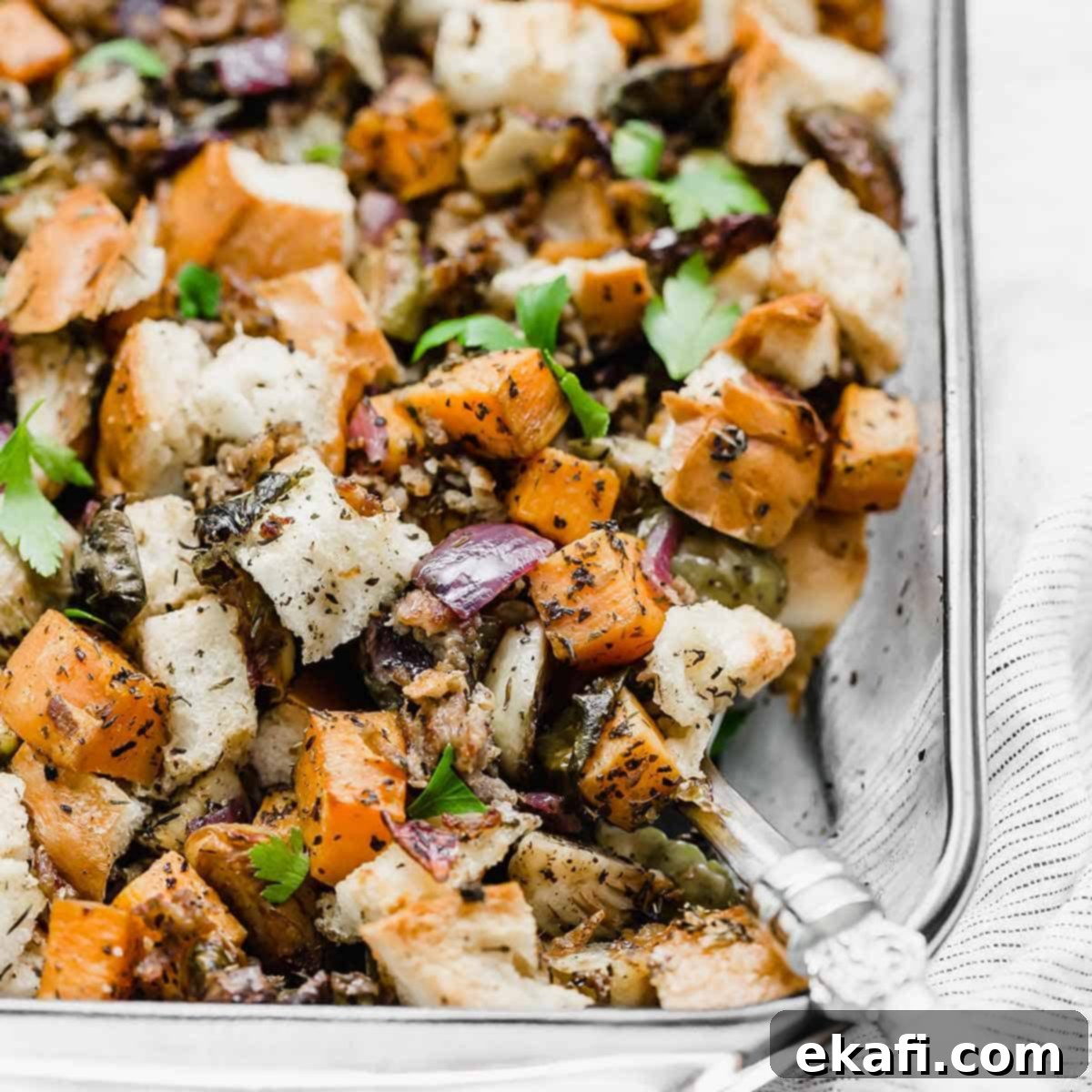
Common Questions About Italian Sausage Stuffing
While some dishes freeze well, we strongly advise against freezing this particular Italian sausage stuffing recipe. The delicate balance of textures from the French bread, chicken broth, and roasted vegetables tends to degrade significantly upon freezing and thawing. The bread can become mushy, and the vegetables might turn watery, making for a less enjoyable experience when reheated or re-baked. For optimal taste and texture, this stuffing is best enjoyed fresh or stored in the refrigerator for a few days.
Absolutely, and it’s highly recommended! Incorporating Italian sausage into your stuffing recipe, whether it’s this specific French bread version or even a classic one, adds an incredible depth of savory flavor and a hearty texture that truly elevates the dish. The rich blend of spices typically found in Italian sausage (like fennel, garlic, and paprika) complements traditional stuffing herbs beautifully. If you’re a fan of a meatier, more flavorful stuffing, you could even add some Italian sausage to our Classic Thanksgiving Stuffing Recipe for an extra layer of deliciousness!
A soggy stuffing is almost always the result of adding too much liquid, most commonly chicken broth. The recipe notes emphasize that you might not need to use all the broth provided. The exact amount of liquid required can vary based on several factors, including the type and dryness of your bread, and the natural moisture content of the vegetables you’re using. Always add the broth gradually, stirring after each addition, until the bread cubes are adequately moistened and cohesive, but not drenched. The goal is a tender, flavorful stuffing, not a bread pudding consistency.
Conversely, a dry stuffing typically indicates that it needed more chicken broth, or that the bread was over-baked initially. Achieving the perfect moisture balance is crucial for delicious stuffing: you want the broth to fully coat the stuffing mixture, ensuring every bite is flavorful and tender. If your bread was too hard or crunchy from over-toasting, it might not have absorbed the broth effectively. Remember, the bread should be lightly golden brown and dried out, but not rock hard. Add broth incrementally until the mixture is uniformly moist and holds together without being overly wet, creating that ideal comforting texture.

More Delightful Thanksgiving Recipes
- Irresistible Thanksgiving Pies
- A Roundup of Delicious Thanksgiving Recipes
- Decadent Praline Pumpkin Pie
- Sweet & Sticky Candied Yams
- Creamy Mashed Potatoes with Half and Half
Did you make this recipe? We’d absolutely love to hear about your experience! Leave a star rating and review below, or scroll down to the recipe card to share your feedback there. Your comments help us grow and inspire other home cooks!
Stay up-to-date with our latest recipes and culinary adventures by following us on Instagram, TikTok, YouTube, Facebook, and Pinterest. We love seeing your creations!

Print
SaveSaved!
Review
Italian Sausage Stuffing
Ingredients
- 1 loaf French bread – cut into 1-inch pieces (about 10 cups)
- 8 oz sweet Italian sausage – or hot Italian sausage for a kick
- 16 oz Brussels sprouts – halved or quartered
- 2 cups sweet potato – peeled and cubed (about 1 large)
- 1/2 red onion – cubed or finely chopped
- 2 tablespoons olive oil
- 1 tablespoon dried basil – divided
- 3 teaspoons rubbed sage – divided
- 3 teaspoons thyme leaves – divided
- 6 tablespoons unsalted butter – cut into 6 pieces
- 1 3/4 cups chicken broth – See note #1 (use as needed)
- fresh herbs for garnish (basil, parsley, thyme) – optional
Equipment
-
13″x9″ glass baking pan
-
Large Baking Sheets
-
Large Skillet
Instructions
-
Preheat your oven to 400°F (200°C). Evenly spread the 1-inch cubed French bread pieces on a large baking sheet. Bake for 10-14 minutes, or until the bread is lightly golden brown and slightly firm to the touch. This step is crucial for preventing soggy stuffing. Remove from the oven and transfer the toasted bread cubes to a large mixing bowl.
-
In a large skillet, cook the sweet Italian sausage over medium heat, using a spoon to break it into small, uniform crumbly pieces. Cook for 8-10 minutes, or until the sausage is completely browned and cooked through, with no pink remaining. Carefully drain any excess grease from the skillet before transferring the cooked sausage to the large bowl containing the toasted bread cubes.
Roast the Veggies
-
In a medium-sized bowl, combine the quartered Brussels sprouts, peeled and cubed sweet potato, and cubed red onion. Drizzle with 2 tablespoons of olive oil, then add 1 teaspoon of dried basil, 1 teaspoon of rubbed sage, and 1 teaspoon of thyme. Toss thoroughly to ensure all vegetables are well-coated. Spread the seasoned vegetables in an even layer on a large baking sheet. Roast in the 400°F (200°C) oven for 18-20 minutes, or until they are roasted and the sweet potatoes are slightly tender when pierced with a fork, but not mushy.
-
Carefully transfer the roasted vegetables to the large bowl with the sausage and bread. Add the remaining 2 teaspoons of dried basil, 2 teaspoons of rubbed sage, 2 teaspoons of thyme, and dot with the 6 tablespoons of cubed butter. Toss all ingredients gently to combine. Gradually pour the chicken broth over the mixture, stirring continually until everything is well incorporated and the bread is moistened. Be cautious not to add too much broth; you’re aiming for moist, not soggy, bread cubes to achieve the perfect stuffing consistency.
Bake the Fall Stuffing
-
Reduce the oven temperature to 375°F (190°C).
-
Transfer the entire stuffing mixture into a butter-greased 13″x9” casserole dish, spreading it out evenly. Cover the dish tightly with aluminum foil and bake for 25 minutes. Then, remove the foil and continue baking for another 20-25 minutes, or until all the liquid has been absorbed, the top is beautifully golden brown, and the stuffing is heated through and slightly crispy on top.
-
Remove the finished stuffing from the oven. For an extra touch of freshness and flavor, garnish with fresh herbs such as basil, parsley, or thyme, if desired, before serving warm. Enjoy this delightful Italian Sausage Stuffing!
Notes
Storage & Reheating: Any leftover Italian sausage stuffing can be stored in an airtight container in the refrigerator for 3-4 days. For optimal taste and texture when reheating, use the oven rather than a microwave. Cover with foil to prevent drying, then uncover for the last few minutes to crisp the top.
Sausage Variation: For a spicier kick, use hot Italian sausage. For a leaner option, turkey sausage works wonderfully in place of pork sausage.
Recipe inspired by Recipe Critic.
